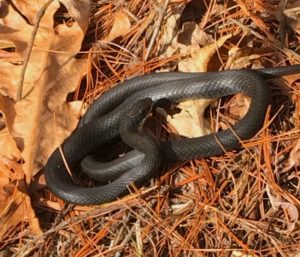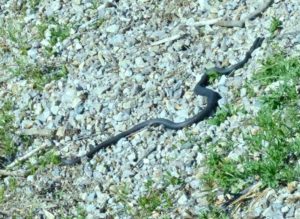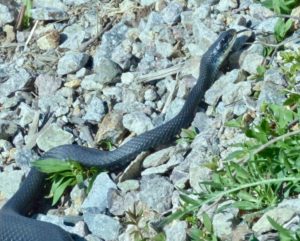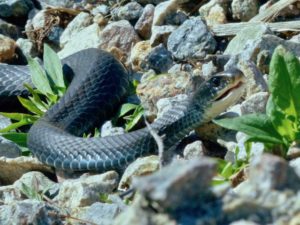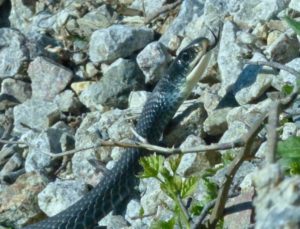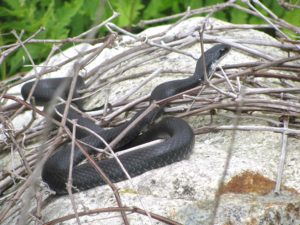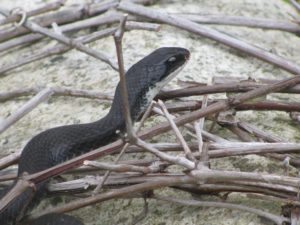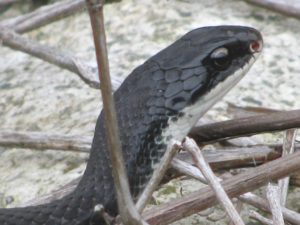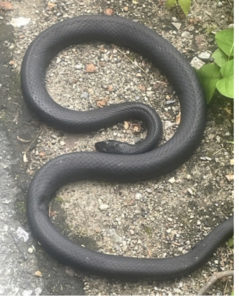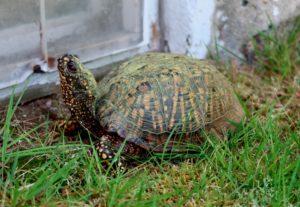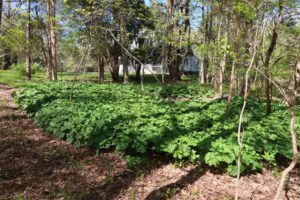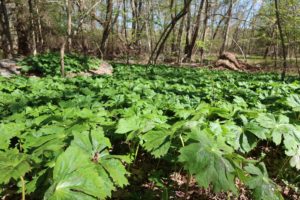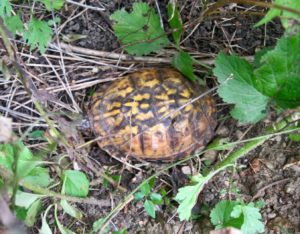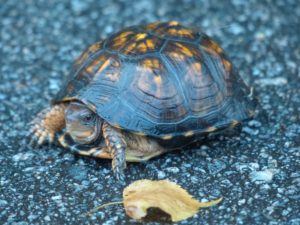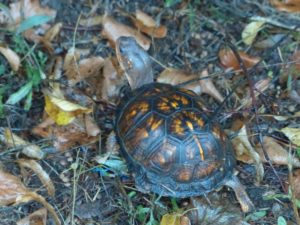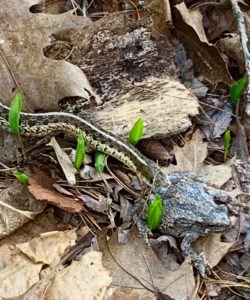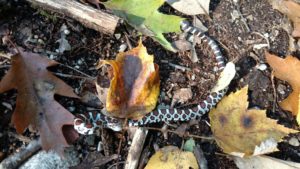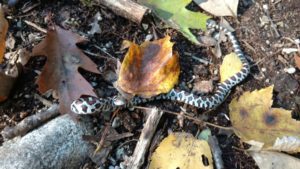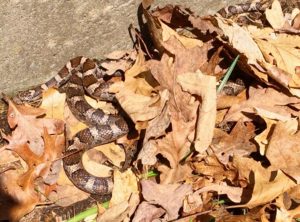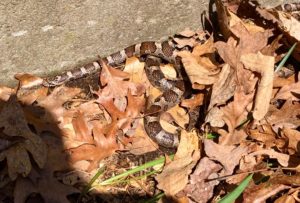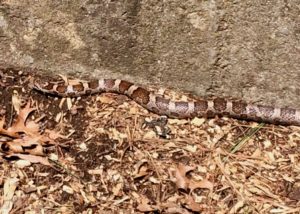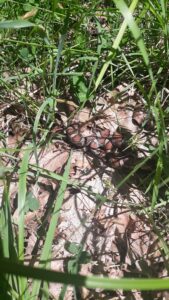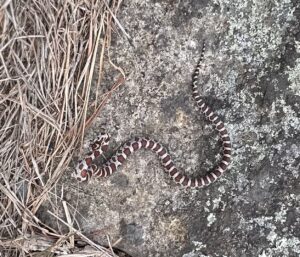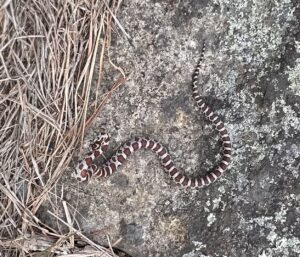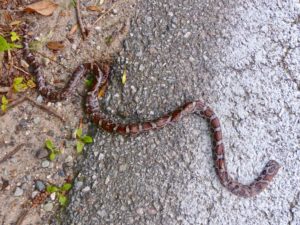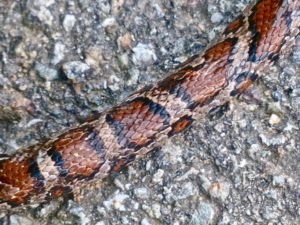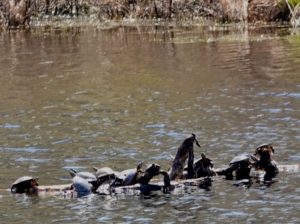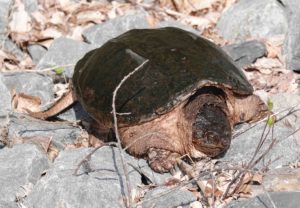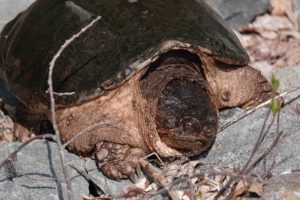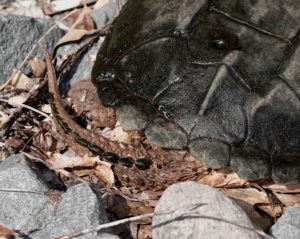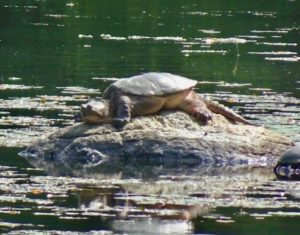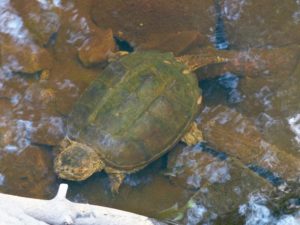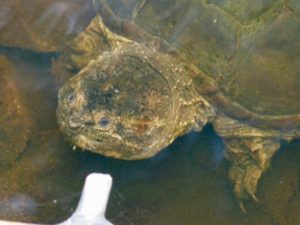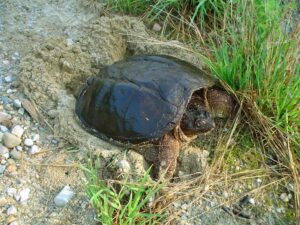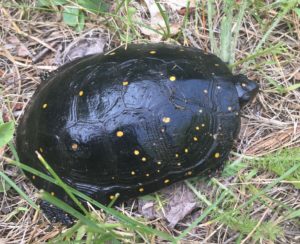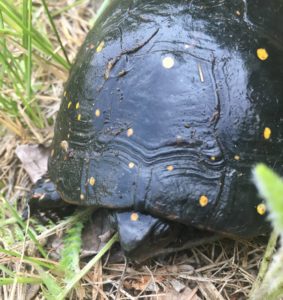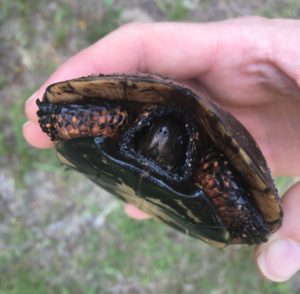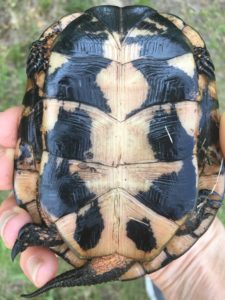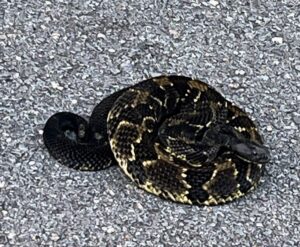Sightings – Reptiles
Observer: Marcia Tranavitch
Observation Date: 1/11/20
Observation Time: mid-day
Observation Location: on top of Pierce’s Hill on the Warner Trail (which is also the Bay Circuit Trail at this point)
Common Name: Black racer
Scientific Name: Coluber constrictor
Comments: Reptiles are cold-blooded so they warm themselves by basking. This black racer was seen sunning itself on a warm winter day. It didn’t stretch out for me but I would estimate it was about 2 feet long. This must be a young one because lack racers can reach 5 feet in length.
Although they are not venemous, black racers are fast (hence their name) and can be aggressive toward humans.
More Information: Snakes of Massachusetts
Observer: Paul Lauenstein
Observation Date: 5/7/18
Observation Time: 8:15 a.m.
Observation Location: Moose Hill Audubon Wildlife Sanctuary
Common Name: Black racer
Scientific Name: Coluber constrictor
Comments: This black racer was sunning itself in the cool of the morning, and continuously monitoring its surroundings by “tasting” the air with its forked tongue.
More Information: Snakes of Massachusetts
Observer: Paul Lauenstein
Observation Date: 6/14/09
Observation Time: morning
Observation Location: Moose Hill Farm, Trustees of Reservations land
Common Name: Black Racer
Scientific Name: Coluber constrictor
Comments: Photos taken on Sunday, 6/14/09 at SFOC’s Biodiversity Day event at Trustees of Reservations on Moose Hill.
More Information: UMass Amherst Natural Resources & Environmental Conservation
Observer: Bruce Lewis
Observation Date: 8/10/23
Observation Time: 4:00 pm
Observation Location: Near the intersection of Moose Hill st and Walpole st. In the section of the woods bordering the street and just outside the field where Wards Berry Farm grows crops.
Common Name: Black Racer
Scientific Name: Coluber constrictor
Comments: Reptiles are cold-blooded so they warm themselves by basking. This black racer was seen sunning itself on a warm winter day. It didn’t stretch out for me but I would estimate it was about 2 feet long. This must be a young one because lack racers can reach 5 feet in length.
Although they are not venemous, black racers are fast (hence their name) and can be aggressive toward humans.
More Information: Snakes of Massachusetts
Observer: David Dearborn
Observation Date: 5/22/24
Observation Time: 9:35 a.m.
Observation Location: 104 Mountain St.
Common Name: Eastern Box Turtle
Scientific Name: Terrapene carolina
Comments: Spotted this Eastern Box Turtle checking out our cellar window this morning. The little guy was moving pretty quickly, it seemed, for a turtle, walking towards our back yard, headed who knows where but in the direction of Sucker Brook which borders part of our property. We have a very large patch of May apple, visible from Mountain Street, currently in bloom. I’m told that the small fruit that grows on the underside of the leaf is a favorite food of the box turtle.
Box turtles are a Species of Special Concern in Massachusetts. A Species of Special Concern is any species of plant or animal which has been documented by biological research and inventory to have suffered a decline that could threaten the species if allowed to continue unchecked or that occurs in such small numbers or with such a restricted distribution or specialized habitat requirements that it could easily become threatened within the Commonwealth.
Please do not move or disturb box turtles except to move them out of harm’s way, such as when they are found in a roadway.
More Information: Natural History and Endangered Species
What to do if you find a turtle: https://www.mass.gov/guides/turtles-of-massachusetts#turtles-in-the-road
Observer: Paul Lauenstein
Observation Date: 7/19/10
Observation Time: 7:30 a.m.
Observation Location: undisclosed location in Sharon (to protect the turtle)
Common Name: Eastern Box Turtle
Scientific Name: Terrapene carolina
Comments: I spotted this rare male box turtle (Terrapene carolina) in Sharon (exact location undisclosed to protect the turtle) at 7:30 on Monday, July 19, 2010. Although it appeared at first to want to cross the busy road, it eventually turned around and trundled off away from the road, perhaps deterred by the 6″ granite curb.
Box turtles live within a very small territory (about 200 yards in any direction). They become familiar with where to find food and shelter within that area as the seasons change. It is not a good idea to move a box turtle to a new area because it won’t know where to find food, and it may try to find its way back to its home territory, crossing roads and taking the risk of getting run over in the process.
Box turtles are extremely long-lived (up to 100 years or more), slow to mature, and have relatively few offspring per year. These characteristics, along with a propensity to get hit by cars, make the box turtle a species particularly susceptible to human-induced problems. It is listed by the Massachusetts Natural Heritage and Endangered Species Program (NHESP) as a Species of Special Concern (SC).
Excerpt from NHESP web site:
“Most turtles require multiple types of habitats to fulfill all of their survival needs. For example, the Blanding’s Turtle overwinter in permanent wetlands, often move to vernal pools to feed, nest in open gravelly upland areas, and move among marshes, shrub swamps and other wetland types throughout the summer. In order to access all of these resources in one season, they will often have to cross roads. Roads are one of the most prominent threats to turtles. The number one threat is habitat loss, fragmentation, and degradation due to residential and commercial development. Other threats include collection as pets (both commercial and incidental), disease, increased levels of predation in urban and suburban areas, and succession of nesting and other open habitats.”
For tips on what to do if you encounter a box turtle, and how to report sightings of rare species, see the NHESP website.
More Information: Massachusetts Turtle Atlas
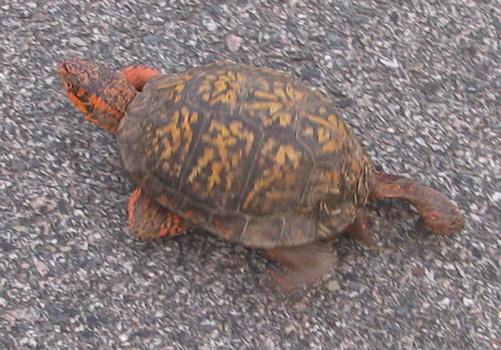
Observer: Rene & David Dearborn
Observation Date: 8/10/23
Observation Time:
Observation Location: 104 Mountain St.
Common Name: Eastern Box Turtle
Scientific Name: Terrapene carolina
Comments: Box turtles are a Species of Special Concern in Massachusetts. A Species of Special Concern is any species of plant or animal which has been documented by biological research and inventory to have suffered a decline that could threaten the species if allowed to continue unchecked or that occurs in such small numbers or with such a restricted distribution or specialized habitat requirements that it could easily become threatened within the commonwealth.
Please do not move or disturb box turtles except to move them out of harm’s way, such as when they are found in a roadway.
More Information: Natural History and Endangered Species
What to do if you find a turtle: https://www.mass.gov/guides/turtles-of-massachusetts#turtles-in-the-road
Observer: Zahava Friedman
Observation Date: 9/3/17
Observation Time: 6:45 p.m.
Observation Location: along Gavins Pond Rd.
Common Name: Eastern Box Turtle
Scientific Name: Terrapene carolina
Comments: This specimen was discovered by Zahava’s dog, Yoshi, when they were out for a walk. Box turtles are a species of special concern. They are vulnerable to getting run over by cars. Although box turtles can live over 100 years, females do not reach sexual maturity until they are about 13 years old.
More Information: Natural History and Endangered Species
What to do if you find a turtle: https://www.mass.gov/guides/turtles-of-massachusetts#turtles-in-the-road
Observer: Paul Lauenstein
Observation Date: 3/17/11
Observation Time: 2:20 p.m.
Observation Location: Coach Lane
Common Name: Garter Snake
Scientific Name: Thamnophis sirtalis
Comments: This is a common snake. It is harmless.
More Information: Wikipedia
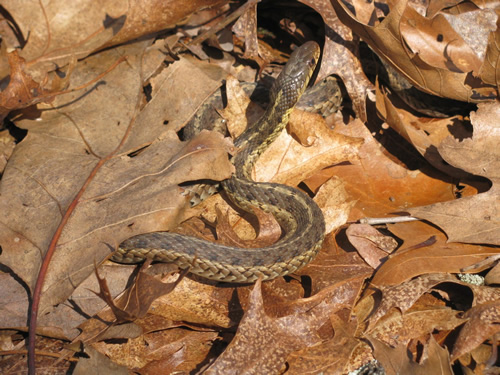
Observer: Megan Baker and Leslie Koval
Observation Date: 5/3/20
Observation Time: 3:20 p.m.
Observation Location: near Briggs Pond
Common Name: Garter Snake
Scientific Name: Thamnophis sirtalis
Comments: This garter snake seems to have bitten off more than it can swallow. Outcome unknown.
More Information: Wikipedia
Observer: Kathy Farrell
Observation Date: 10/17/18
Observation Time: 3:46 p.m.
Observation Location: Beaver Brook Trail
Common Name: Milk Snake
Scientific Name: Lampropeltis triangulum
Comments: Beautiful snake in middle of trail. Not very big…maybe 6-8″. Maybe juvenile? Was shaking its tail at me! No rattle.
More Information: https://en.wikipedia.org/wiki/Milk_snake
Observer: Marcia Tranavitch
Observation Date: 5/2/20
Observation Time: noon
Observation Location: against the retaining wall in my garden at 24 Pine St.
Common Name: Milk Snake
Scientific Name: Lampropeltis triangulum
Comments: I encountered him/her among the leaves I was cleaning out at the edge of the woods on my property.
I estimate this milk snake was at least 3 feet in length. To appreciate its length, note the additional section of the snake that is visible in the upper right corner of two of these three photos.
More Information: https://en.wikipedia.org/wiki/Milk_snake
Observer: Sarah and Matt Charron Naughton
Observation Date: 6/13/24
Observation Time: 11:08 a.m.
Observation Location: Borderland State Park – Pond Edge Trail
Common Name: Milk Snake
Scientific Name: Lampropeltis triangulum
Comments: We entered the park and began our hike along the Pond Edge Trail heading towards the Lodge. We noticed this snake just to the right of the trail in some leaves and tall grass.
More Information: https://en.wikipedia.org/wiki/Milk_snake
Observer: Kate Kavanagh
Observation Date: 6/3/10
Observation Time: 4:15 p.m.
Observation Location: South Pleasant Street
Common Name: Milk Snake
Scientific Name: Lampropeltis triangulum
Comments: This beautiful snake was slowly moving along the foundation of the house in the front garden bed. Disappeared into the gap behind the front step. Sadly, I was not fast enough with my camera.
More Information: UMass Amherst Natural Resources and Environmental Conservation
Observer: Jean Zaniewski
Observation Date: 9/23/2025
Observation Time: 1:00 p.m.
Observation Location: Moose Hill Bluff Trail, on top of second west facing overlook
Common Name: Eastern Milk Snake
Scientific Name: Lampropeltis triangulum
Comments: It was about 2 feet long. When they feel threatened, milk snakes sometimes swish their tails in dead leaves to make a rustling sound and simulate a rattlesnake in order to scare away would-be predators.
More Information: https://en.wikipedia.org/wiki/Milk_snake
Observer: Paul Lauenstein
Observation Date: 9/12/13
Observation Time: 4:30 p.m.
Observation Location: Moose Hill Street
Common Name: Milk Snake
Scientific Name: Lampropeltis triangulum
Comments: Sad to see this beautiful non-venomous milk snake run over by a car. Milk snakes are generally docile, but when alarmed, they sometimes shake their tails against dead leaves to imitate the sound of a rattlesnake.
More Information: Virginia Herpetological Society
Observer: Paul Lauenstein
Observation Date: 5/29/13
Observation Time: 1:30 p.m.
Observation Location: Gavins Pond Dam
Common Name: Musk turtle
Scientific Name: Sternotherus odoratus
Comments: This small turtle, which only grows to 5″ in length, is common in Sharon. When disturbed, it emits a disagreeable odor, which accounts for both its common and scientific names.
This individual presumably came ashore to lay eggs. Believe it or not, musk turtles are known to climb high up into the branches of shrubs and trees.
More Information: Savannah River Ecology Laboratory
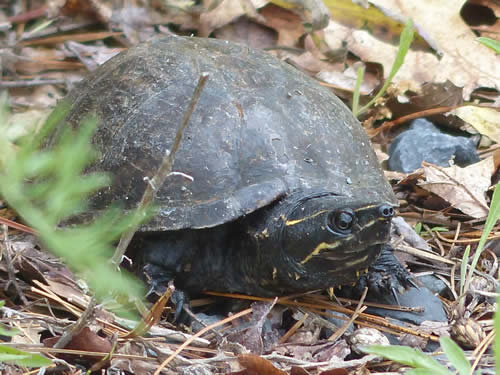
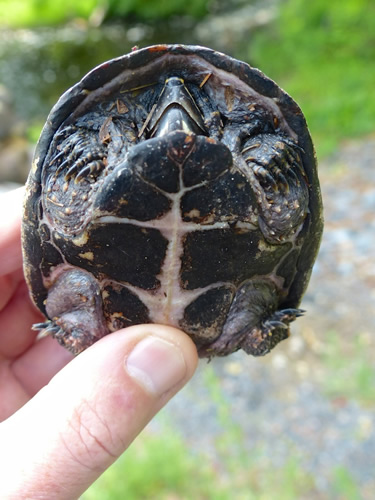
Observer: Paul Lauenstein
Observation Date: 5/31/12
Observation Time: 8:20 a.m.
Observation Location: Gavins Pond Dam
Common Name: Northern Water Snake
Scientific Name: Nerodia sipedon
Comments: This big water snake was stalking a frog.
More Information: http://www.snake-removal.com/northernwatersnake.html
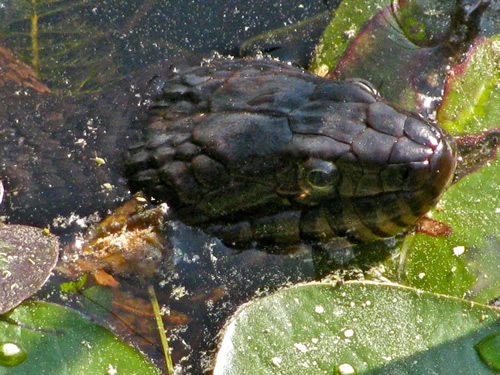
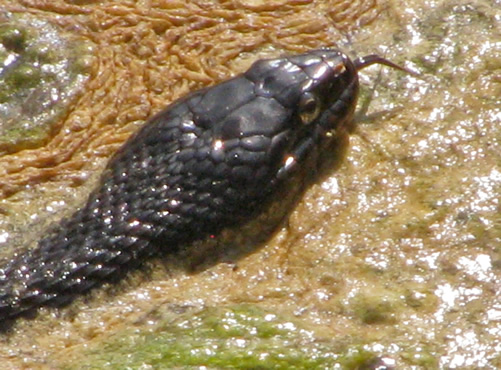
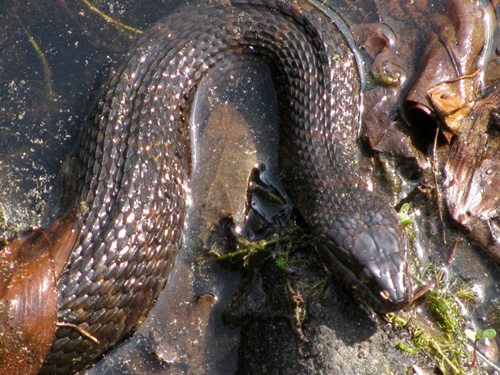
It tastes the air with its forked tongue.
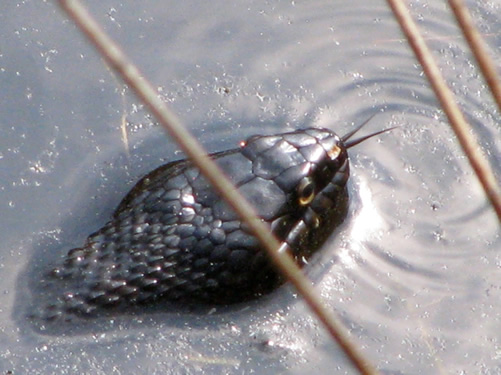
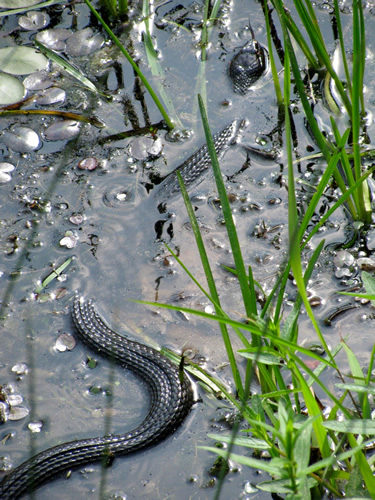
Its scales have ridges called “keels.”
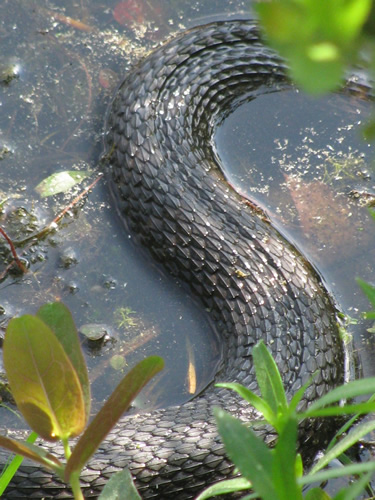
The frog got away.
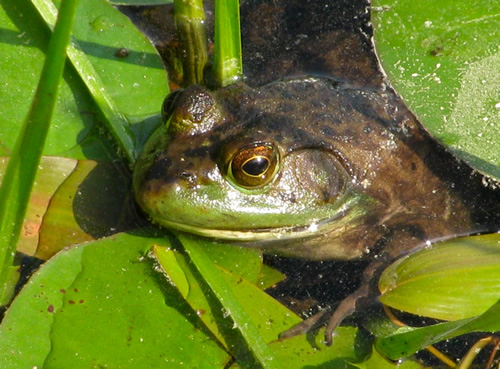
Observer: Paul Lauenstein
Observation Date: 6/12/13
Observation Time: 1:30 p.m.
Observation Location: Gavins Pond Dam
Common Name: Northern Water Snake
Scientific Name: Nerodia sipedon
Comments: The older northern water snakes get, the blacker they become. This mature specimen appears to be all black, but the underside is still colorful. Non-venomous northern water snakes are sometimes confused with venomous water moccasins, which live farther south. Even older northern water snakes that look black when on shore may appear banded when swimming through the water.
Note the ridges on the scales, called “keels.”
More information on this one-minute video: https://www.youtube.com/watch?v=Uw6W8NaJmfo
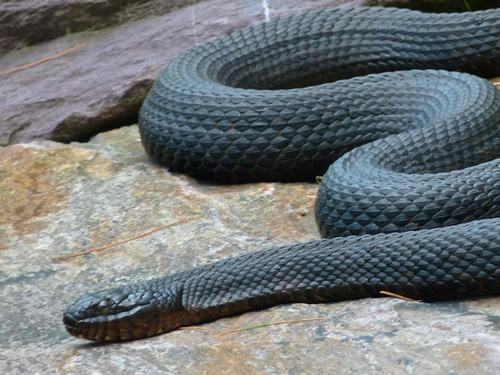
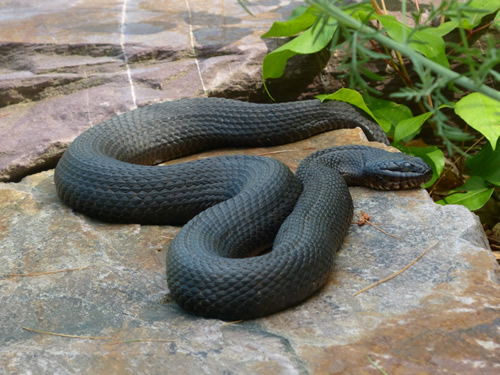
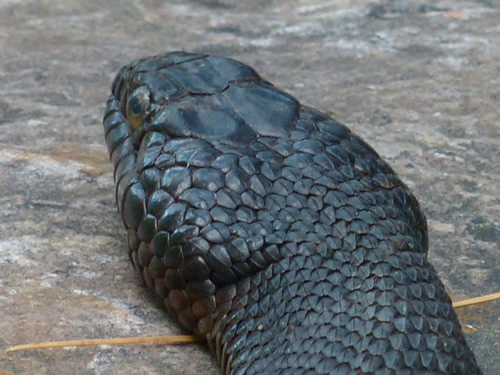
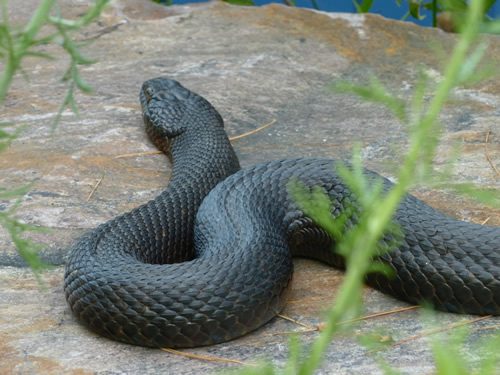
Observer: Paul Lauenstein
Observation Date: 7/9/11
Observation Time: 3:45 p.m.
Observation Location: Gavins Pond Dam
Common Name: Northern Water Snake
Scientific Name: Nerodia sipedon
Comments: Water snakes are not venomous, but they can be large (4 feet long or more, and as thick as a man’s wrist) and aggressive. This one was more interested in avoiding me than attacking me.
More Information: Savannah River Ecology Laboratory
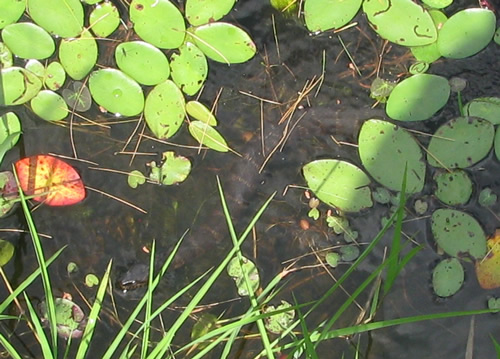
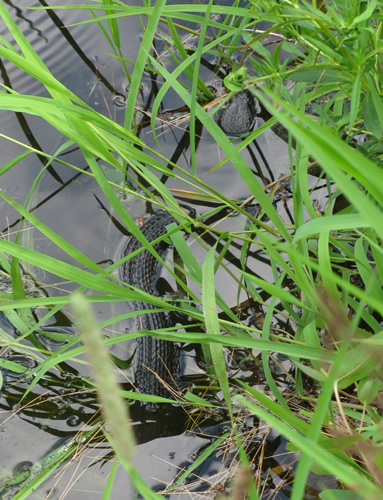
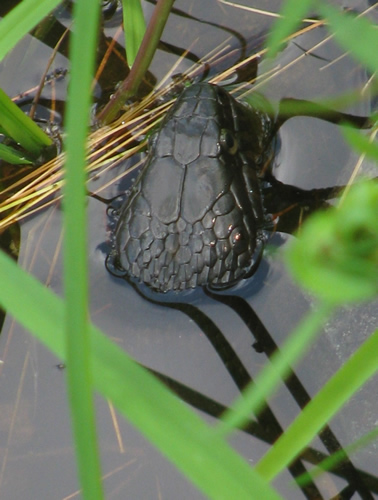
The scales have ridges called “keels.”
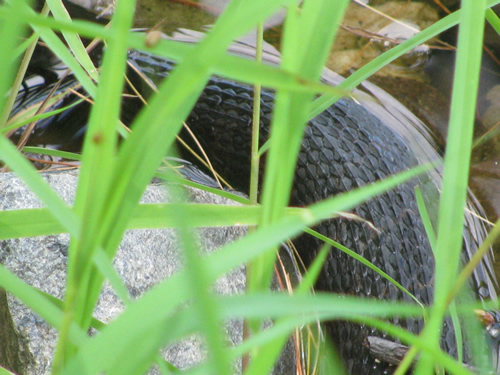
Observer: Alex Hackman
Observation Date: 8/14/10
Observation Time: 11:00 a.m.
Observation Location: Outlet of Gavins Pond
Common Name: Northern Water Snake
Scientific Name: Nerodia sipedon
Comments: Lucky to see this water snake slither by while taking stream flow measurements.
More Information: Wikipedia
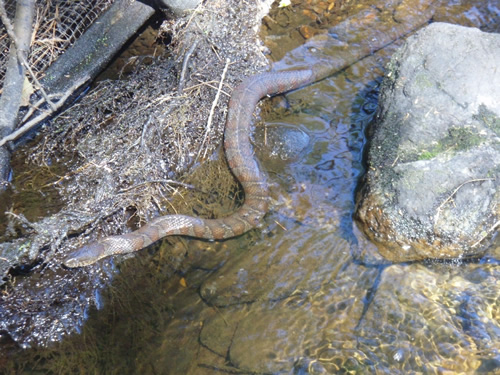
Observer: Paul Lauenstein
Observation Date: 8/6/12
Observation Time: 1:10 p.m.
Observation Location: outflow pool below Gavins Pond Dam
Common Name: Northern Water Snake (juvenile)
Scientific Name: Nerodia sipedon
Comments: Young northern water snake males are more brightly marked than older ones, which tend to be all black.
More Information: Snakes of Massachusetts
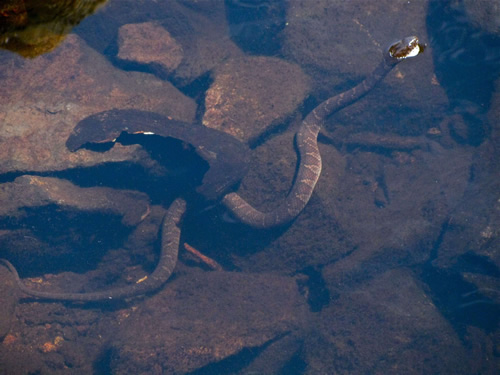
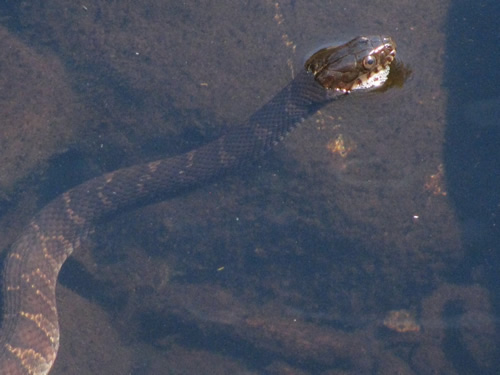
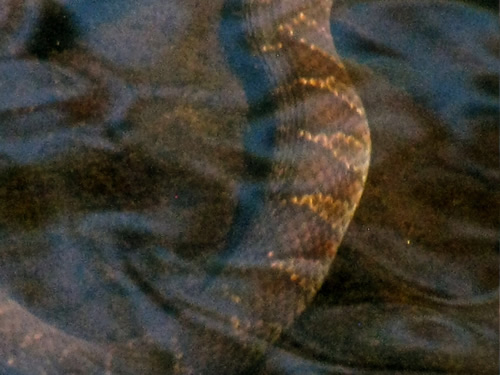
Observer: Paul Lauenstein
Observation Date: 7/25/10
Observation Time: 10:40 a.m.
Observation Location: Gavins Pond Dam
Common Name: Painted Turtle
Scientific Name: Chrysemys picta
Comments: Painted turtles mostly stay in the water, or climb out to sun themselves on logs. This one was walking around on Gavins Pond Dam.
More Information: Warner Nature Center
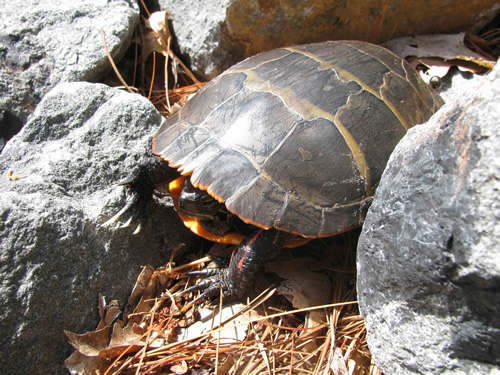
Observer: Paul Lauenstein
Observation Date: 7/6/11
Observation Time: 4:50 p.m.
Observation Location: Gavins Pond outflow pool
Common Name: Painted Turtle
Scientific Name: Chrysemys picta
Comments: I found this specimen on the dam, so I photographed it and then put it back in the water. In June, painted turtles lay their eggs in holes they dig with their hind legs in sunny patches of sandy soil.
More Information: Wikipedia
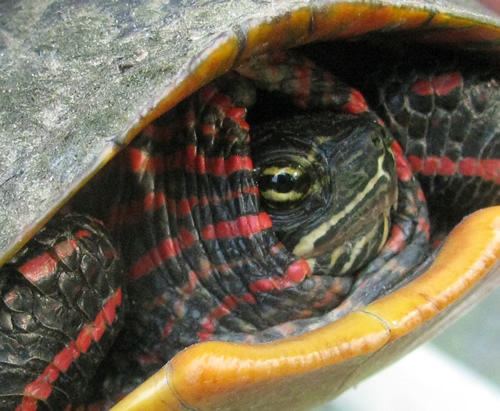
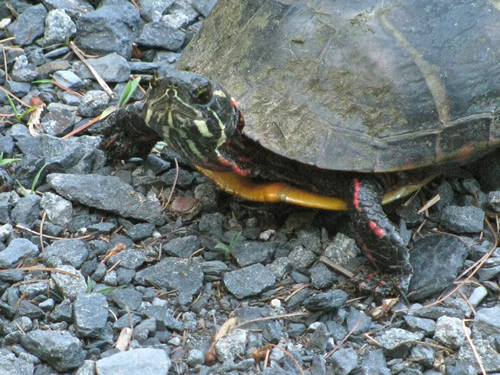
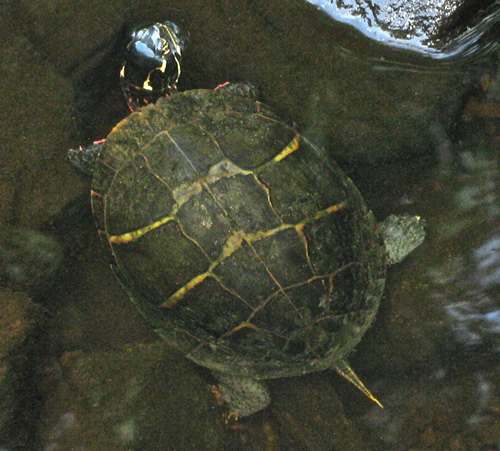
Observer: Paul Lauenstein
Observation Date: 5/3/20
Observation Time: 10:45 a.m.
Observation Location: Gavins Pond
Common Name: Painted Turtle
Scientific Name: Chrysemys picta
Comments: Turtles are cold-blooded. These painted turtles were sunning themselves on a log to escape the chilly water. In June, painted turtles lay their eggs in holes they dig with their hind legs in sunny patches of sandy soil.
More Information: Wikipedia
Observer: Anna Baur
Observation Date: 6/11/24
Observation Time: 4:00 pm
Observation Location: Old Wolomolopoag Street
Common Name: Ringneck Snake
Scientific Name: Diadophis punctatus
Comments: Ringneck snakes prefer moist woodlands as their habitat. This is also habitat for an important prey item, redback salamanders. Although salamanders make up the bulk of their diet, ringnecks will also feed on earthworms, insects and, on occasion, fish.
As relatively small snakes, they rarely bask in the open and are generally found under cover (rocks, logs, boards, debris) during the day. Like the salamanders on which they prey, ringnecks are usually nocturnal. They are most active in spring and fall and are rarely seen during summer. Among all the New England snakes, ringnecks are most likely to end up in someone’s basement. Ringneck snakes rarely bite, but may release a foul musk when handled.
More Information: Snakes of Massachusetts
Observer: Paul Lauenstein
Observation Date: 5/3/20
Observation Time: 8:30 a.m.
Observation Location: Near Billings Brook downstream of Gavins Pond dam
Common Name: Snapping Turtle
Scientific Name: Chelydra serpentina
Comments: Reptiles are cold-blooded. This individual had hauled itself out of the chilly water to warm itself in the sun. In early June, snapping turtles come out of the water, dig a hole in sandy areas, and bury their eggs. The eggs hatch in late summer or early fall.
Temperature during incubation influences the sex of the hatchlings. See: https://www.jstor.org/stable/1563778?seq=1
More Information: Tufts Wildlife Clinic and Mass Audubon’s guide to turtle species
The snapping turtle’s tail looks like something you might find in Jurassic Park.
Observer: Eldad Ganin
Observation Date: 6/23/23
Observation Time: 4:59 p.m.
Observation Location: Hammershop Pond
Common Name: Snapping Turtle
Scientific Name: Chelydra serpentina
Comments: Snapping turtles are found in all sorts of water bodies, from rivers to lakes to marshes. They eat many different plants and animals, but become more vegetarian as they age.
Snapping turtles can be aggressive and deliver a painful bite if threatened. Give them plenty of space and be aware that their neck can stretch the length of the shell. Never grab one by the tail—you could seriously injure the turtle.
More Information: Tufts Wildlife Clinic and Mass Audubon’s guide to turtle species
Observer: Paul Lauenstein
Observation Date: 7/22/16
Observation Time: 6:15 p.m.
Observation Location: Outflow pool below Gavins Pond dam
Common Name: Snapping Turtle
Scientific Name: Chelydra serpentina
Comments: Snapping turtles come out of the water and lay their eggs in sandy areas in early June. The eggs hatch in late summer or early fall.
More Information: Tufts Wildlife Clinic and Mass Audubon’s guide to turtle species
Observer: Paul Lauenstein
Observation Date: 8/21/10
Observation Time: 7:50 a.m.
Observation Location: Gavins Pond Road
Common Name: Snapping Turtle
Scientific Name: Chelydra serpentina
Comments: It is a common misconception that snapping turtles may be safely picked up by the tail with no harm to the animal; in fact, this has a high chance of injuring the turtle, especially the tail itself and the vertebral column. Lifting the turtle with the hands is difficult and dangerous. Snappers can stretch their necks back across their own carapace and to their hind feet on either side to bite. Also, their claws are sharp and capable of inflicting significant lacerations.
Manual lifting is best accomplished by grabbing the base of the tail right near the shell, lifting a tiny bit and sliding a flat hand with the fingers tightly together between its back legs and under its stomach. The snapper is then lifted off the ground much like a pizza, keeping its head pointed away from anyone. They cannot bite under their stomachs. If available wearing thick work gloves is advised when handling adult snappers. Washing hands or using hand sanitizer is advised after handling any turtle (wild or pet) as they can carry Salmonella bacteria.
More Information: Wikipedia
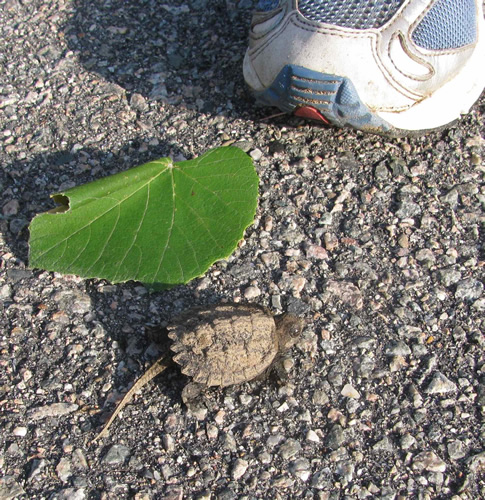
Observer: Thomas Belli
Observation Date: 9/4/22
Observation Time: 1:30 pm
Observation Location: Pud’s Pond (Borerland State Park)
Common Name: Snapping Turtle
Scientific Name: Chelydra serpentina
Comments: It was huge!
Temperature during incubation influences the sex of the hatchlings. See: https://www.jstor.org/stable/1563778?seq=1
More Information: Tufts Wildlife Clinic and Mass Audubon’s guide to turtle species
Observer: Paul Lauenstein
Observation Date: 6/9/05
Observation Time: 7:00 a.m.
Observation Location: Gavins Pond Road
Common Name: Snapping Turtle
Scientific Name: Chelydra serpentina
Comments: Snapping turtles lay their eggs in early to mid June. The eggs hatch in late summer.
More Information: Tufts Wildlife Clinic and Mass Audubon’s guide to turtle species
Observer: Paul Lauenstein
Observation Date: 8/25/10
Observation Time: 7:30 a.m.
Observation Location: Spillway at Gavins Pond dam
Common Name: Snapping Turtle
Scientific Name: Chelydra serpentina
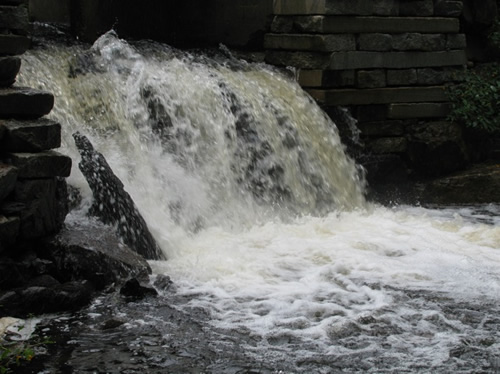
On August 25 the spillway at the Gavins Pond dam was flowing strongly following four inches of rain in three days.
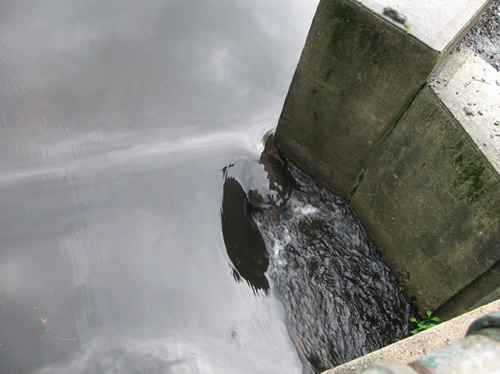
A good-sized snapping turtle had gotten swept by the current into the spillway at the Gavins Pond dam. It was hanging on to the concrete lip at the entrance of the spillway by its front claws. If it let go, it would have been swept over the falls and onto the shallow rocks, which might have been fatal. A few years ago, I saw a broken carapace of a big snapping turtle in the outflow pool. I suppose it had gotten swept over the falls and broke its shell.
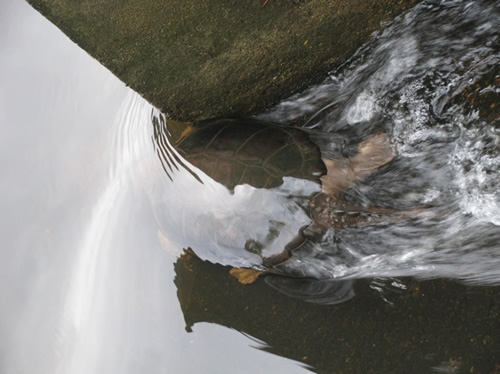
Moments after I took the above picture, the turtle’s right front claw lost its grip, and the turtle lurched a couple inches backward toward the falls. I thought it was a goner, but it continued to hang on by its left front claw. It somehow managed to pull its right claw forward against the strong current and regained its grip on the lip of the spillway. Very slowly and carefully, it maneuvered itself toward the pond.
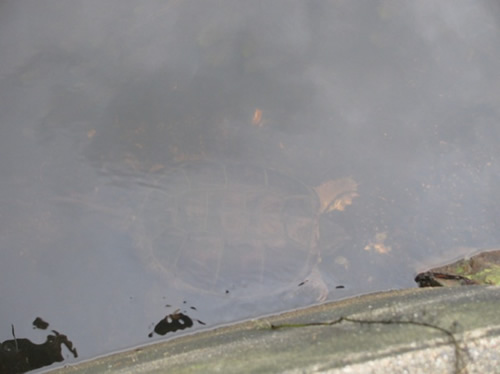
Once out of the current, it rested briefly, and I was able to get this last photo before it swam off.
More Information: Wikipedia
Observer: Paul Lauenstein
Observation Date: 6/28/10
Observation Time: 8:00 a.m.
Observation Location: Gavins Pond Road behind Shaw’s Plaza
Common Name: Spotted Turtle (female)
Scientific Name: Clemmys guttata
Comments: This female spotted turtle may have been searching for a sandy spot to lay eggs. It may take up to 7 years for a spotted turtle to reach sexual maturity. Or perhaps it was returning to deeper water after the vernal pool dried up where it was feeding on amphibian eggs. Young spotted turtles only have one yellow spot per scute. More yellow spots appear as they age.
Many turtles get run over by cars. If you find a turtle on a road, dead or alive, please report it to the Massachusetts Turtle Atlas
More Information: Mass. Natural Heritage and Endangered Species Program (NHESP) “Massachusetts Forestry Conservation Management Practices for Spotted Turtles”
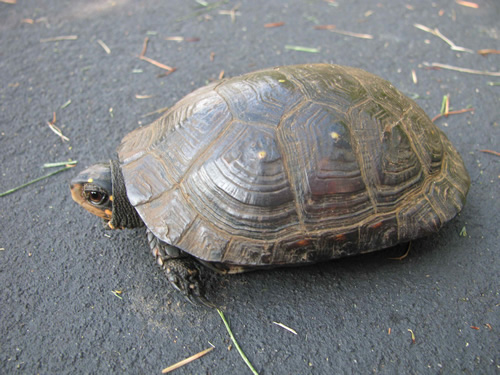
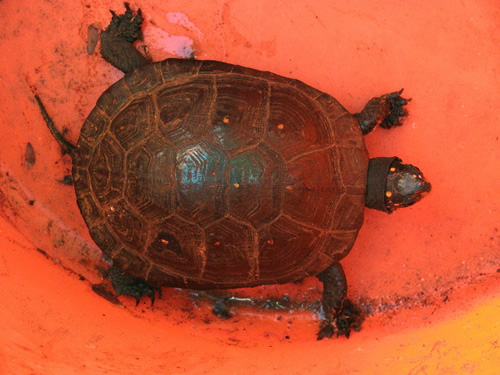
Observer: Zahava Friedman
Observation Date: 7/17/18
Observation Time:
Observation Location: Gavins Pond Road
Common Name: Spotted Turtle
Scientific Name: Clemmys guttata
Comments: Rare in Massachusetts. Spotted turtles visit vernal pools in spring to feed on amphibian eggs. When the pools dry up in summer, they must trek overland to return to a permanent pond. Unfortunately, this often entails crossing roads.
More Information: Natural History and Endangered Species Program of Massachusetts
Observer: Kurt Buermann
Observation Date: 7/28/17
Observation Location: King Philips Trail, Sharon
Common Name: Spotted Turtle
Scientific Name: Clemmys guttata
Comments: Rare in Massachusetts. Spotted turtles visit vernal pools in spring to feed on amphibian eggs. When the pools dry up in summer, they must trek overland to return to a permanent pond. Unfortunately, this often entails crossing roads.
More Information: Natural History and Endangered Species Program of Massachusetts
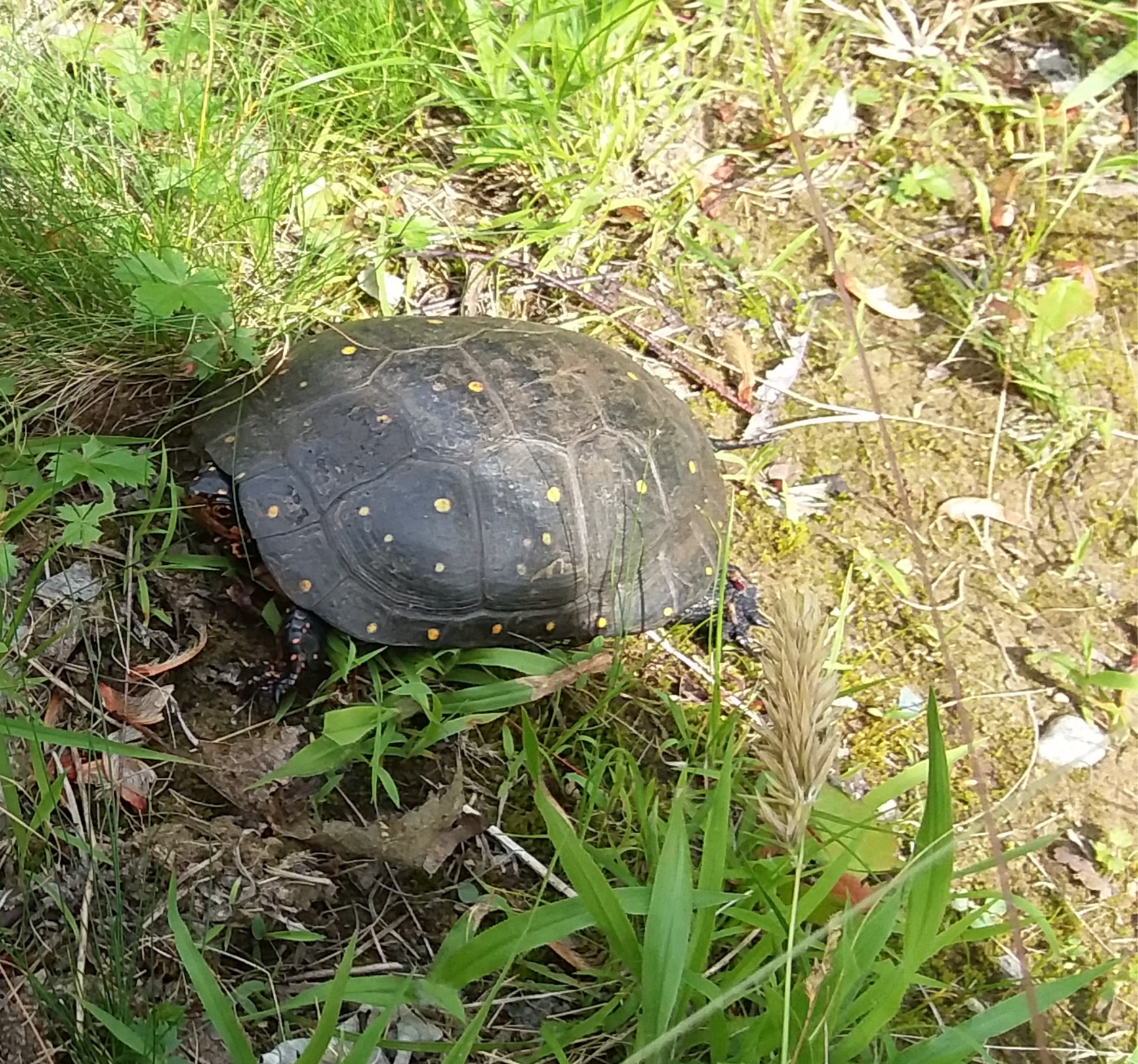
Observer: Elizabeth James
Observation Date: 9/28/24
Observation Time: afternoon
Observation Location: Bishop Road
Common Name: Timber Rattlesnake
Scientific Name: Crotalus horridus
Comments: These mild-mannered, venomous, and very rare snakes are listed as endangered in Massachusetts. Please help protect them by maintaining a safe distance. That should not be hard to do, given that rattlesnakes give fair warning before they strike. This one was gently removed from the road by a police officer with a special snake pole.
Rattlesnakes live in rocky dens. On cool days when the sun is shining, they come out to bask on the warm rocks. In summer they migrate down to wetlands where they fatten up on rodents and other small prey. This seasonal migration puts them at risk of being run over when they cross roads, which is one reason they are so rare. This one was probably warming itself on the asphalt, and might have been run over had the officer not rescued it.
According to Tom Palmer’s excellent history of rattlesnakes in New England called Landscape with Reptile, there has never been a verifiable death from a rattlesnake bite in New England.
- First offense: A fine of at least $500, up to 90 days in jail, or both
- Second or subsequent offense: A fine of at least $5,000, up to 180 days in jail, or both
- Civil assessments: Up to $10,000 for each violation
More Information: Mass.gov

